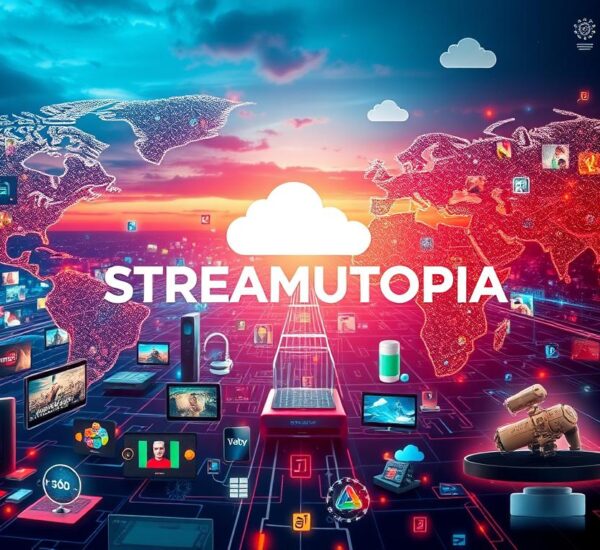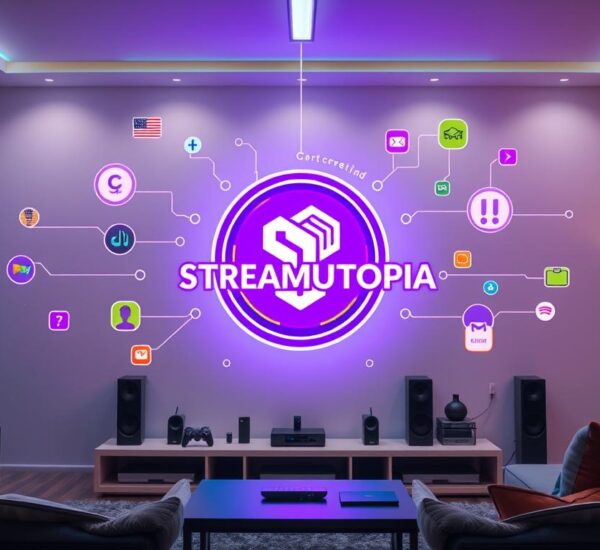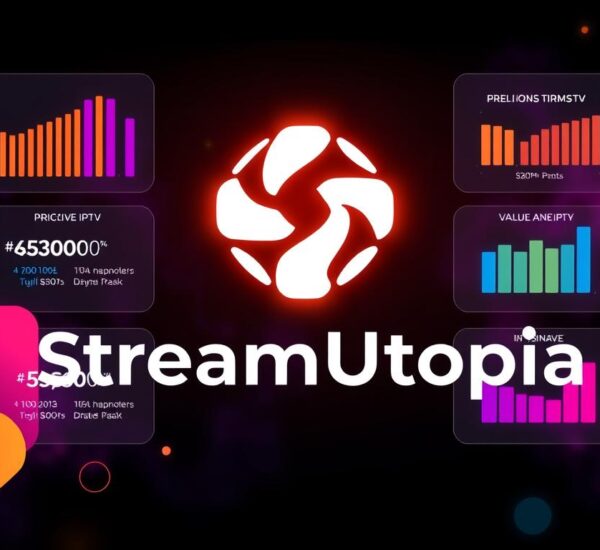Did you know that virtual events are predicted to generate $400 billion in revenue by 2027? This staggering statistic highlights the immense impact that IPTV, or Internet Protocol Television, is having on the future of conferences and events. IPTV offers a revolutionary digital platform that allows participants to attend conferences and meetings remotely from anywhere in the world, eliminating geographical barriers and enhancing collaboration.
Key Takeaways:
- IPTV is transforming the way conferences and events are conducted, enabling remote participation from anywhere.
- Virtual events have the potential to generate $400 billion in revenue by 2027.
- IPTV technology enhances accessibility, engagement, and collaboration among conference participants.
- The future of conferences is being shaped by the advancements in event technology and digital platforms.
- Virtual event platforms powered by IPTV offer a seamless and immersive experience for attendees.
The Importance of AV Equipment in Meeting Rooms
Good AV equipment is essential in meeting rooms to ensure effective communication and collaboration. In today’s digital age, where remote work and global teams are becoming increasingly common, having the right audiovisual technology can make a significant difference in the success of meetings and presentations.
Enhancing Communication
Video calls have become an integral part of modern business communication. With high-quality AV equipment, meeting participants can engage in face-to-face conversations, no matter where they are located. The combination of clear video and audio ensures that everyone can hear and see each other without any disruptions, allowing for better understanding and smoother collaboration.
Seamless Multimedia Sharing
Whether it’s sharing presentations, documents, or videos, accurate and uninterrupted multimedia sharing is crucial in meeting rooms. AV equipment, such as large display screens, allows participants to follow along effortlessly, ensuring that everyone is on the same page. This seamless sharing of information facilitates discussions, decision-making, and productivity.
Sound Systems for Clear Audio
High-quality sound systems are essential components of AV equipment in meeting rooms. Clear and crisp audio ensures that everyone can hear each other without straining, leading to more effective communication. It eliminates the frustration of unclear or distorted sound, allowing all participants to actively engage in discussions and contribute their ideas.
Facilitating Remote Collaboration
AV equipment is particularly crucial for facilitating remote collaboration. With the right tools, team members who are not physically present in the meeting room can still actively participate and contribute. Whether it’s through video calls or audio conferencing, AV equipment enables seamless remote collaboration, breaking down geographical barriers and increasing the efficiency of virtual meetings.
| Benefits of Good AV Equipment in Meeting Rooms |
|---|
| Enhanced communication and collaboration |
| Seamless multimedia sharing for productive meetings |
| Clear audio with high-quality sound systems |
| Facilitation of remote collaboration |
Investing in AV equipment for meeting rooms is a wise decision for any organization. It not only enables effective communication and collaboration but also helps in creating a professional and productive work environment.
Small Huddle Rooms: Essential for Close-Knit Team Collaboration
Small huddle rooms provide an intimate setting for close-knit team collaboration. These spaces are designed to foster effective communication and teamwork, enabling seamless interaction and brainstorming sessions. With the increasing popularity of remote work and dispersed teams, huddle rooms offer a convenient solution for team members to collaborate, regardless of their physical location.
In these small meeting spaces, the layout is carefully optimized to promote face-to-face interaction and engagement. A compact table placed at the center serves as the focal point, bringing team members together in a cohesive manner. Surrounding the table, comfortable chairs encourage a relaxed atmosphere, enabling participants to fully focus and contribute their ideas.
To facilitate communication and collaboration, huddle rooms are equipped with essential audiovisual components. A high-quality camera and microphone enable remote team members to join meetings via video conferencing, ensuring everyone’s voices are heard and opinions valued. The display screen allows for shared content, fostering dynamic discussions and efficient presentations. Additionally, a reliable speakerphone guarantees crystal-clear audio, eliminating any disruptions or misunderstandings during meetings.
Benefits of Small Huddle Rooms:
- Promote teamwork and foster collaboration
- Facilitate effective communication, both in-person and remote
- Create an intimate space that encourages open discussion
- Provide a comfortable and conducive environment for brainstorming
- Enhance productivity and decision-making processes
Example of a Small Huddle Room Setup:
| Component | Description |
|---|---|
| Compact Table | A small table placed at the center of the room, enabling close collaboration. |
| Comfortable Chairs | Ergonomic chairs designed to ensure participant comfort during extended discussions. |
| High-Quality Camera and Microphone | A camera and microphone setup that allows remote team members to join the meeting and actively participate. |
| Display Screen | A large screen for sharing content and presentations, fostering engagement and visual communication. |
| Speakerphone | A reliable speakerphone system that ensures clear audio during conversations and conference calls. |
Medium Meeting Rooms: Where Cross-Department Meetings Take Place
Medium meeting rooms offer a versatile and functional space for a variety of meeting types, including departmental meetings, client presentations, and interactive workshops. These rooms can accommodate 6 to 10 participants, striking the right balance between intimacy and formality.
One of the key aspects of medium meeting rooms is their inclusion of audiovisual components to enhance presentations and collaboration. These components typically include:
- PTZ camera and microphone for seamless video conferencing
- One or more display screens for sharing presentations and visual content
- Speakerphone for clear and effective audio communication
The furniture in medium meeting rooms is designed to be modular and flexible, allowing for different meeting arrangements and styles. This adaptability enables participants to create an environment that best suits their specific needs. Additionally, control systems are installed to streamline the management of the audiovisual equipment, ensuring a smooth and hassle-free meeting experience.
Benefits of Medium Meeting Rooms:
1. Cross-Department Collaboration: Medium meeting rooms serve as a central hub where teams from different departments can come together to share ideas, strategize, and work towards common goals.
2. Client Presentations: These rooms provide a professional and well-equipped space for delivering impactful client presentations, showcasing products or services, and engaging with potential clients.
3. Interactive Workshops: Medium meeting rooms are ideal for hosting interactive workshops and training sessions, facilitating hands-on learning experiences and fostering collaboration among participants.
Medium meeting rooms with their audiovisual components and flexible arrangements create an environment that promotes effective communication, collaboration, and productivity. Whether it’s a brainstorming session, a client pitch, or a team training, these rooms offer the necessary tools and space to ensure a successful meeting outcome.
Boardrooms: The Hub for Formal and Strategic Meetings
In the world of business, formal and strategic meetings require a setting that exudes professionalism and facilitates effective communication. Boardrooms serve as the ideal space for such meetings, providing an environment that promotes focus, collaboration, and decision-making.
Boardrooms are designed to accommodate a significant number of attendees, making them perfect for executive-level discussions and important presentations. One of the key features of these rooms is the large central table, which serves as the focal point for the meeting. Its spacious surface allows participants to comfortably organize their materials, engage in discussions, and collaborate effectively.
| Key Features of Boardrooms: |
|---|
| 1. Advanced Audiovisual Systems: |
| Boardrooms are equipped with state-of-the-art audiovisual systems, ensuring seamless communication and engaging presentations. These advanced systems include high-quality video conferencing equipment, large display screens, integrated sound systems, and intuitive control interfaces. |
| 2. Executive Chairs: |
| To enhance comfort and maintain a professional atmosphere, boardrooms are furnished with executive chairs. These chairs provide ergonomic support, allowing attendees to focus on the meeting at hand without any discomfort. |
By leveraging advanced audiovisual systems and providing a conducive environment for formal and strategic meetings, boardrooms foster effective decision-making and drive the success of organizations.
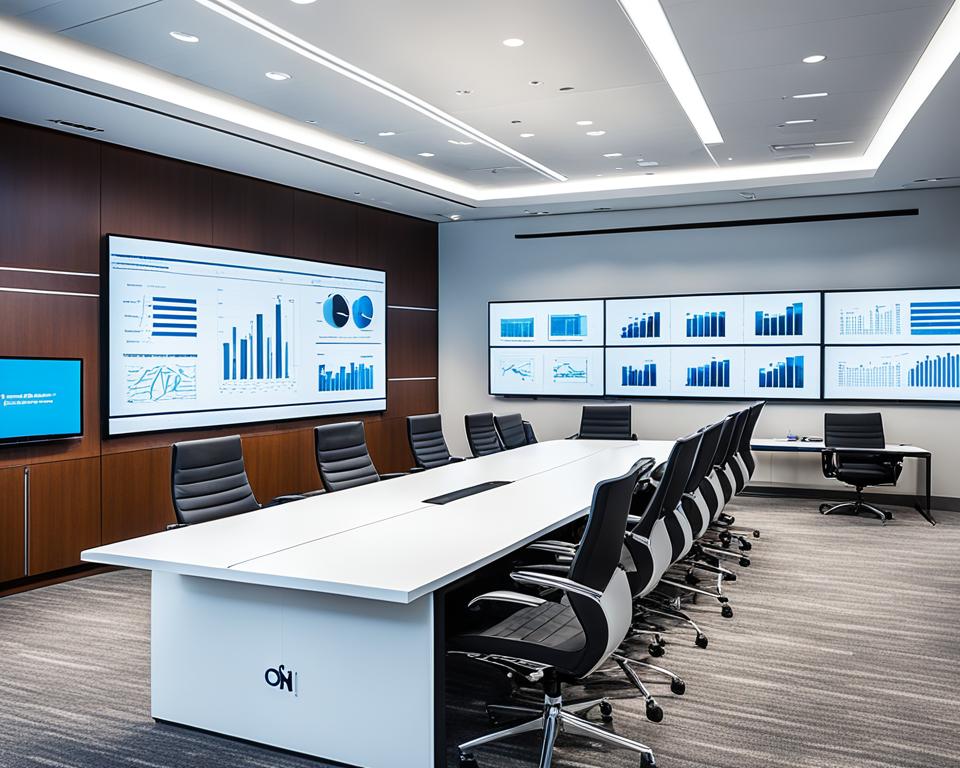
Whether it’s finalizing business strategies, discussing financial performance, or making critical decisions, boardrooms offer the necessary infrastructure and atmosphere for productive meetings that shape the future of organizations.
The Impact of OTT Platforms on Media Industry Trends
OTT (Over-the-Top) platforms have revolutionized the media industry, offering viewers fresh and meaningful content that can be accessed anytime, anywhere. These platforms have transformed the way media is consumed, introducing new trends and opportunities for content creators and distributors.
One of the key impacts of OTT platforms is the ability to enable live media broadcasting through technologies like HTTP Live Streaming (HLS). With HLS, viewers can stay updated with the latest news and events as they happen, without being restricted by geographical limitations.
Another significant trend in the media industry is the rise of AVOD (Advertising-based Video On Demand). Platforms such as Netflix have adopted ad support, allowing advertisers to reach a large audience through targeted advertisements. This model provides a sustainable revenue stream for content creators and ensures that viewers can access free content.
OTT platforms also offer various monetization models beyond AVOD. This includes pay-per-view, where viewers can pay to access specific content, and coupons, which provide discounts or incentives for purchases. These models create additional revenue opportunities for content creators and diversify the ways in which they can monetize their content.
| OTT Platform Monetization Models | Features |
|---|---|
| AVOD | – Advertising-based revenue model – Allows viewers to access free content – Advertisers can reach a large audience through targeted advertisements |
| Pay-per-view | – Viewers pay to access specific content – Provides additional revenue for content creators – Allows flexibility in content pricing and accessibility |
| Coupons | – Offers discounts or incentives for content purchases – Rewards viewers for engagement and loyalty – Creates opportunities for partnerships with brands and advertisers |
Current Trends in OTT and Their Influence on the Media Industry
The Over-the-Top (OTT) industry is constantly evolving, bringing new trends and innovations that shape the media landscape. Understanding and staying abreast of these trends is essential for content creators, distributors, and consumers alike. Let’s explore some current trends in the OTT industry and their influence on the media industry.
Rise of FAST Channels
One significant trend in the OTT industry is the emergence of FAST (Free Ad-Supported Television) channels. FAST channels allow viewers to access a wide range of content, including live streaming, without the need for a subscription. This trend has revolutionized the way viewers consume media, providing them with free access to an extensive library of movies, TV shows, and exclusive content.
AVOD Adoption by Major Platforms
The adoption of AVOD (Advertising-Based Video On Demand) by major OTT platforms is another noteworthy trend that has gained momentum in recent years. Platforms like Netflix have started integrating advertising into their content, providing a new monetization model. This move opens up opportunities for brands to reach a vast audience while allowing platforms to generate revenue beyond traditional subscription models.
Innovative Monetization Trends
The OTT industry is continuously exploring innovative ways to monetize content. One emerging trend is the introduction of pay-per-view bundles and coupons. Content creators and distributors can package specific shows or events as pay-per-view offerings, allowing viewers to access premium content on demand. Coupons provide an attractive incentive for viewers to purchase or rent content at discounted prices. These monetization trends offer flexibility for both consumers and content providers, enabling new revenue streams and increasing viewer engagement.
Interactive Streaming
Interactive streaming is revolutionizing the viewing experience, allowing viewers to actively participate in content consumption. With interactive streaming capabilities, viewers can choose their preferred camera angles, alternate endings, or participate in real-time polls and quizzes. This level of interactivity not only enhances viewer engagement but also provides valuable data insights for content creators and advertisers.
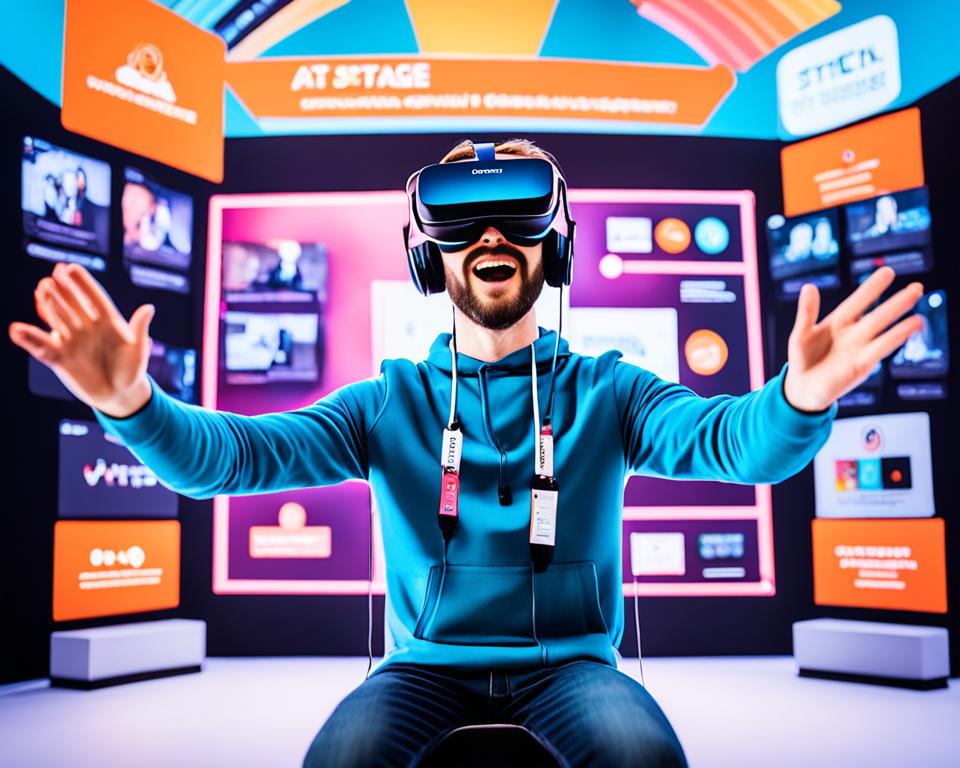
Impact on the Media Industry
These current trends in the OTT industry have a profound influence on the media industry as a whole. They shape the way content is distributed, consumed, and monetized.
| Trend | Impact on Media Industry |
|---|---|
| FAST Channels | Increased accessibility to a wide range of content, challenging traditional TV models and providing viewers with more choices. |
| AVOD Adoption | New revenue streams for platforms and increased brand exposure opportunities, while also providing viewers with free or more affordable content options. |
| Innovative Monetization Trends | Diversification of revenue streams for content creators, increased viewer engagement through interactive purchasing options, and flexibility in content consumption. |
| Interactive Streaming | Enhanced viewer engagement, personalized viewing experiences, and valuable data insights for content creators and advertisers. |
These trends are revolutionizing the media industry, providing new opportunities for content distribution, revenue generation, and viewer engagement. As the OTT industry continues to evolve, staying informed and adapting to these trends will be crucial for staying competitive in the ever-changing media landscape.
The Future of OTT and Its Potential Impact on the Media Industry
The future of OTT (Over-the-Top) platforms holds immense potential for the media industry, bringing forth exciting possibilities and transformative advancements. As technology continues to evolve, several key trends are set to shape the future of OTT and its impact on the media landscape.
1. 5G Technology: Revolutionizing Media Broadcasting
5G technology is poised to revolutionize media broadcasting, offering high-speed connectivity and low latency that will enable seamless streaming and content creation from anywhere. With 5G networks, viewers can expect ultra-high-definition video quality, faster buffering times, and an overall enhanced streaming experience. This new era of connectivity will unlock a world of opportunities for content creators and broadcasters, enabling them to push the boundaries of production value and audience engagement.
2. Localized Media Content: Enhancing Engagement
In the era of globalization, the demand for localized media content is becoming increasingly prominent. By providing multilingual support and cultural assimilation, OTT platforms can enhance audience engagement on a global scale. Localizing media content allows viewers to consume content in their preferred language and facilitates a deeper connection with the content itself. This trend will empower content creators to reach diverse audiences while fostering a sense of inclusivity and cultural relevance.
3. Innovative Trends in Live Streaming: Immersive Experiences
Immersive live streaming experiences will redefine the way audiences consume media content. Augmented reality (AR) and virtual reality (VR) technologies will play a significant role in creating engaging and interactive experiences for viewers. By blending the virtual and physical worlds, live streaming can transport audiences to new dimensions, offering a truly immersive and memorable experience. From virtual concerts and sporting events to virtual travel experiences, the possibilities are vast, opening up new avenues for content creators to captivate their audiences.
4. Personalized User Experience: AI-driven Recommendations
Personalization is key to providing a tailored and captivating user experience. AI-based recommendation engines will continue to leverage user data and preferences to curate personalized content recommendations. By analyzing user behavior, viewing patterns, and demographic information, OTT platforms can deliver content that aligns with individual preferences, increasing viewer satisfaction and retention. This level of personalization will enable viewers to discover new content, explore niche genres, and create a truly customized entertainment journey.
As the future unfolds, the combination of 5G technology, localized media content, innovative trends in live streaming, and personalized user experiences will shape the OTT landscape and transform the way the media industry operates. Content creators, broadcasters, and viewers alike can look forward to an era of unparalleled connectivity, engagement, and immersive storytelling.
Conclusion
In conclusion, the convergence of IPTV and XR technologies is revolutionizing the future of conferences and the media industry. IPTV enables the hosting of virtual events, providing increased engagement and accessibility for participants from around the world. The incorporation of XR technologies such as Virtual Reality (VR), Augmented Reality (AR), and Mixed Reality (MR) is transforming communication, education, and entertainment.
The combination of IPTV and XR technologies presents immense opportunities for software developers in Latin America (LATAM) to shape the digital landscape. By leveraging the potential of IPTV and XR, LATAM developers can spearhead the evolution of virtual events and immersive media experiences. This innovation has the potential to redefine how conferences are conducted and consumed, creating new possibilities for collaboration and knowledge sharing.
As the world embraces these technologies, it is crucial for businesses and industries to adapt and leverage the advantages they offer. Virtual events, powered by IPTV, allow organizations to overcome geographical barriers and engage a global audience. XR technologies enable interactive and immersive experiences, enhancing the way we learn, communicate, and entertain ourselves.
In a rapidly evolving digital landscape, embracing IPTV and XR technologies is essential for businesses looking to stay competitive and deliver exceptional experiences to their audiences. By embracing these technologies and capitalizing on the opportunities they present, businesses can reshape the future of conferences and media consumption, driving innovation and creating new avenues for success.
FAQ
How is IPTV shaping the future of conferences?
What is the importance of AV equipment in meeting rooms?
What are small huddle rooms and why are they important?
What are medium meeting rooms and their purpose?
What makes boardrooms unique for formal and strategic meetings?
What is the impact of OTT platforms on the media industry?
What are the current trends in OTT and their influence on the media industry?
What does the future of OTT hold and how will it impact the media industry?



